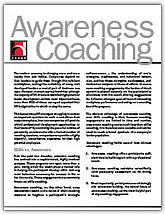 Evidence shows that at least 50% of individuals in leadership have, will, or are failing. The vast majority of suggested solutions revolve around high potential identification, leadership development programs and the like. The purpose of such initiatives is to identify the individuals who should be leaders, but given the statistic above, one has to wonder about their effectiveness.
Evidence shows that at least 50% of individuals in leadership have, will, or are failing. The vast majority of suggested solutions revolve around high potential identification, leadership development programs and the like. The purpose of such initiatives is to identify the individuals who should be leaders, but given the statistic above, one has to wonder about their effectiveness.
The methods above could use a little tweaking. Instead of focusing primarily on who should lead, organizations should place equal impetus on who should follow. An individual not being cut out for or even having the desire to lead is not in and of itself a bad thing. Lest we forget, leaders have to have individuals to lead, and it is those who are led that drive the success or failure of their leader. The term “followers” typically incites a negative response in our minds, however, workers, soldiers, and players are the backbone of any successful grouping of people: an army of only generals is no army at all. For a more recent analogy, imagine the NBA playoffs consisting only of head coaches Erik Spoelstra and Scott Brooks without their respective Heat and Thunder. It simply doesn’t work.
That said, a look through the annals of promotion would quickly reveal that most individuals end up in managerial or upper level leadership positions based on strong performance. This promoting strategy relies on a mindset we have all adopted, and for good reason as it makes logical sense: promote those who do well. Almost inevitably, one of those promotions will eventually place an individual in a position to manage people, and it is at that point logic often begins to breakdown.
Traditional logic fails because good leadership is comprised of much more than just strong performance. By taking a black and white approach and promoting leaders solely based on performance, organizations can potentially shoot themselves in the foot – actually in both feet as the repercussions can emerge on two fronts. Let’s continue with the NBA analogy above: there can be little argument that LeBron James is a phenomenal basketball player. In an organizational culture his performance ratings would be off the charts, and thus, by traditional thinking, LeBron should be promoted. So let’s hypothetically pull LeBron from the hardwood and move him into a more senior position, say head coach. Makes sense, right? Of course it doesn’t. What’s left is a team with big shoes to fill (pun intended) in a small forward, and an individual who has been pulled from an area of strength into an area in which he may or may not excel. Does LeBron have what it takes to be the coach? Does he even want to be the coach?
The example above commonly plays out in the arena of sales. Success in a sales role depends upon significantly different KSAOs (Knowledge, Skills, Abilities, and Other Characteristics) than a sales manager, sales director, etc. So before a high performing sales person is moved into a position of leadership, an organization should ask itself whether they want the individual to sell or to lead. The two are not mutually exclusive and it is entirely possible that the individual can successfully do both. It isn’t necessarily logical, however, to expect leadership success based solely on strong sales numbers.
As past behavior is a solid predictor of future behavior, performance metrics should be a critical component in identifying who should lead and who should follow. They should be combined, however, with a few additional variables: values and potential.
Values - Does the individual even desire to lead? Do they want the promotion, or are they content in their current status as a high-performing employee? Will it fuel their passion or will it extinguish their pilot light?
Potential - Does the individual possess the intrinsic characteristics to successfully lead? Do they truly have what it takes?
To summarize, sometimes a soldier should remain a soldier; a small forward a small forward. Some individuals want to lead, some don’t. Some have what it takes, some don’t. Neither side of the coin is right or wrong, as organizations require both leaders and followers, but we cannot expect to figure out who is who by judging performance alone.
 In the face of ever-shrinking budgets and less resources to devote to employee development, many companies face a similar problem: providing current and potential leadership with critical professional development opportunities.
In the face of ever-shrinking budgets and less resources to devote to employee development, many companies face a similar problem: providing current and potential leadership with critical professional development opportunities.

 Evidence shows that at least 50% of individuals in leadership have, will, or are failing. The vast majority of suggested solutions revolve around high potential identification, leadership development programs and the like. The purpose of such initiatives is to identify the individuals who should be leaders, but given the statistic above, one has to wonder about their effectiveness.
Evidence shows that at least 50% of individuals in leadership have, will, or are failing. The vast majority of suggested solutions revolve around high potential identification, leadership development programs and the like. The purpose of such initiatives is to identify the individuals who should be leaders, but given the statistic above, one has to wonder about their effectiveness.  d leadership skills do not necessarily generalize to a global setting. Leadership skills are distinct from having a global perspective, and successful global leadership requires both. The folks at Thunderbird have a robust body of research on the concept of global mindset, complete with a measurement tool (the Global Mindset Inventory, or GMI) and taxonomy of skills and attributes. The good news is that global mindset can be developed. The bad news is that not nearly enough organizations are actively developing global mindsets in their leadership talent pools or organizations.
d leadership skills do not necessarily generalize to a global setting. Leadership skills are distinct from having a global perspective, and successful global leadership requires both. The folks at Thunderbird have a robust body of research on the concept of global mindset, complete with a measurement tool (the Global Mindset Inventory, or GMI) and taxonomy of skills and attributes. The good news is that global mindset can be developed. The bad news is that not nearly enough organizations are actively developing global mindsets in their leadership talent pools or organizations. 